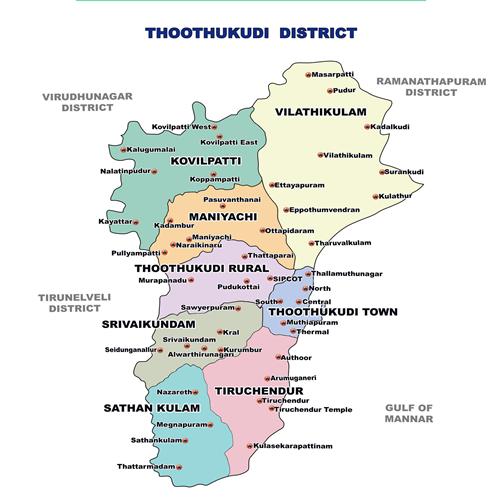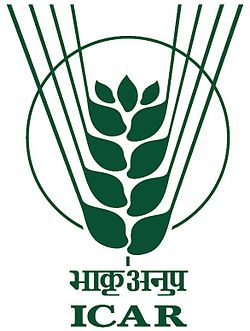+91 461 2269306 pcscadkvk@gmail.com
District Profile
 About District
About District
Traditionally known as “Pearl City” on account of the prevailing Pearl fish in the past in the area, Thoothukudi has a fascinating History. Forming part of the Pandian kingdom between 7th and 9th Century A.D., Thoothukudi remained in the hands of the Cholas during the period between 9th and 12th century. Emergence of Thoothukudi as a maritime port attracted travellers, adventures, and eventually colonizers. The Portuguese were the first to arrive in Thoothukudi in 1532 A.D., followed by the Dutch in 1658 A.D. The English Captured Thoothukudi from the Dutch in 1782 and the East India Company established their control over Thoothukudi in the same year.
On the 20th, October 1986 a new district, carved out of the erstwhile Tirunelveli district was born in Tamil Nadu and named after V.O. Chidambaranar, a great national leader hailing from Ottapidaram who led the Swadeshi Movement in the south. Since 1997 as in the case of other districts of Tamilnadu, this district has also been named after its headquarters town, Thoothukudi.
Thoothukudi became the citadel of freedom struggle in the early of the 20th century. It was in Thoothukudi that the illustrious patriot, V.O. Chidambaram established the first swadesi Stream Navigation Company, sailing the first steamer S.S.Gaelia to Thoothukudi on 1st June 1907.
The minor port of the Thoothukudi anchorage port with lighter age facilities has had flourished traffic for over a century. The first wooden Jetty of this port was commissioned in 1864. This port was being used for export of salt, cotton yarn, senna leaves, palmyrah stalks, palmyrah fibres, dry fish, country drugs etc. to neighboring countries and for import of coal, cotton, copra, pulses and grains. The minor port of the Thoothukudi hand the distinction of being intermediate port handling the highest traffic tonnage of over 1million per annuam.
The salient features of the district include its lengthy, curvy and scenic sea coast which was an international cynosure in the days of yore for its pearl fishery; beautiful coastel villages with their sacred temples, churches and mosques like Tiruchendur, Manappadu and Kayalpattinam respectively, Adhichanallur, one of the cradles of the ancient civilizations, Korkai, an ancient port of the Sangam Pandyas, Kayal, the confluence of the river Thamirabarani with the Bay of Bengal, one of the five illustrious rivers of Tamilnadu, Panchalankurichi, the capital of Veerapandiya Kattabomman, an early martyr, for the cause of freedom, Ettayapuram, the birth place of the great poet Subramanya Bharathi, Ottapidaram the home town of V.O.Chidambaram Pillai, who dared to sail ships as a measure to combat British imperialism;Maniyachi, where Vanchinathan assassinated Ashe, the British Collector for this high –handedness against the leaders during Swadeshi Movement; Kulasekarapattinam and Kurumbur where patriots showed their anger against alien rule ,temple towns like Srivaikundam, Meignanapuram, one of the cradles of Christianity, Thoothukudi, besides being a major port, the earliest settlement of the Portuguese and the Dutch, the tall and dense Palmyra groves and the bushy Odai trees, the Teris and the adjacent coral islands, Idayankudi and Manappadu and the adjacent places which became the headquarters of great missionaries like G.U.Pope, Veeramamunivar, Caldwell and others who, besides their missionary work, contributed a lot for the development of Tamil language and literature and above all the enterprising and hardworking people who now constitute a major trading community in the State.
II – Farming system/enterprise
1. Dry farming - Single crop in a year using NE monsoon
Major crops
Chillies, Pearl millet, Maize, Onion, Fodder sorghum, Sorghum, Black gram, Green gram, Gingelly, Sunflower, Groundnut, Castor, Red gram, Cotton,
Major livestock
Goat, Sheep, Backyard poultry, Cross breed cattle, Non-descript cattle
2. Garden land farming - Two or three crops in a year using open or tube well irrigation.
Major crops
Vegetables, Banana, groundnut, flowers, Chilli, Brinjal, Tomato, Onion, Guards, Drum stick, Cotton
Major livestock
Cross bred cattle, Goat, Backyard poultry
3. Tank fed/ river command area farming – one or two crops in a year.
Major crops
Banana and paddy
Major livestock
Cross bred cattle, Goat, Sheep, Backyard poultry
4. Coastal region
Marine fishing, Goat rearing, Salt pan work
III – Soil Types
Sandy soil (70,324ha)
These are derived from granites trainload, quartzite and sand stones. The colours are due to red hematite and yellow limonite. Base Exchange capacity is from 5 to 25meq per 100 g of the soil and pH generally on the acidic side, ranging from pH 4.5 6.5.
Clay soil (1,88,876ha)
They have a characteristic dark colour, varying from dark brown to deep black. They are formed by the weathering of trap rocks. These soils have a clay percentage ranging from 40-60%.the composition of clay is chiefly of the mon-morillonite group and thus shows swelling and shrinking. The pH varies from 7.5-8.5.
Sandy loam (31,722ha)
Moderate medium sub angular blocky, dry hard, moist friable, wet slightly sticky and very slightly plastic; many fine roots; many fine and common medium pores; rapid permeability; clear smooth boundary; pH6.8.
Sandy clay loam (82,226ha)
Weak fine sun angular blocky; dry slightly hard, moist friable, wet slightly sticky and slightly plastic, slight effervescence; many fine roots; many fine to medium irregular pores; moderately rapid permeability; clear smooth boundary; pH 8.0
Sandy clay (8,688ha)
Moderate medium sub angular blocky, dry hard, moist firm, wet sticky and plastic; many fine roots; few fine pores and mild effervescence; slow permeability; clear wavy boundary; pH7.3.

